brake light MERCEDES-BENZ METRIS 2020 MY20 Operator’s Manual
[x] Cancel search | Manufacturer: MERCEDES-BENZ, Model Year: 2020, Model line: METRIS, Model: MERCEDES-BENZ METRIS 2020Pages: 320, PDF Size: 26.38 MB
Page 7 of 320
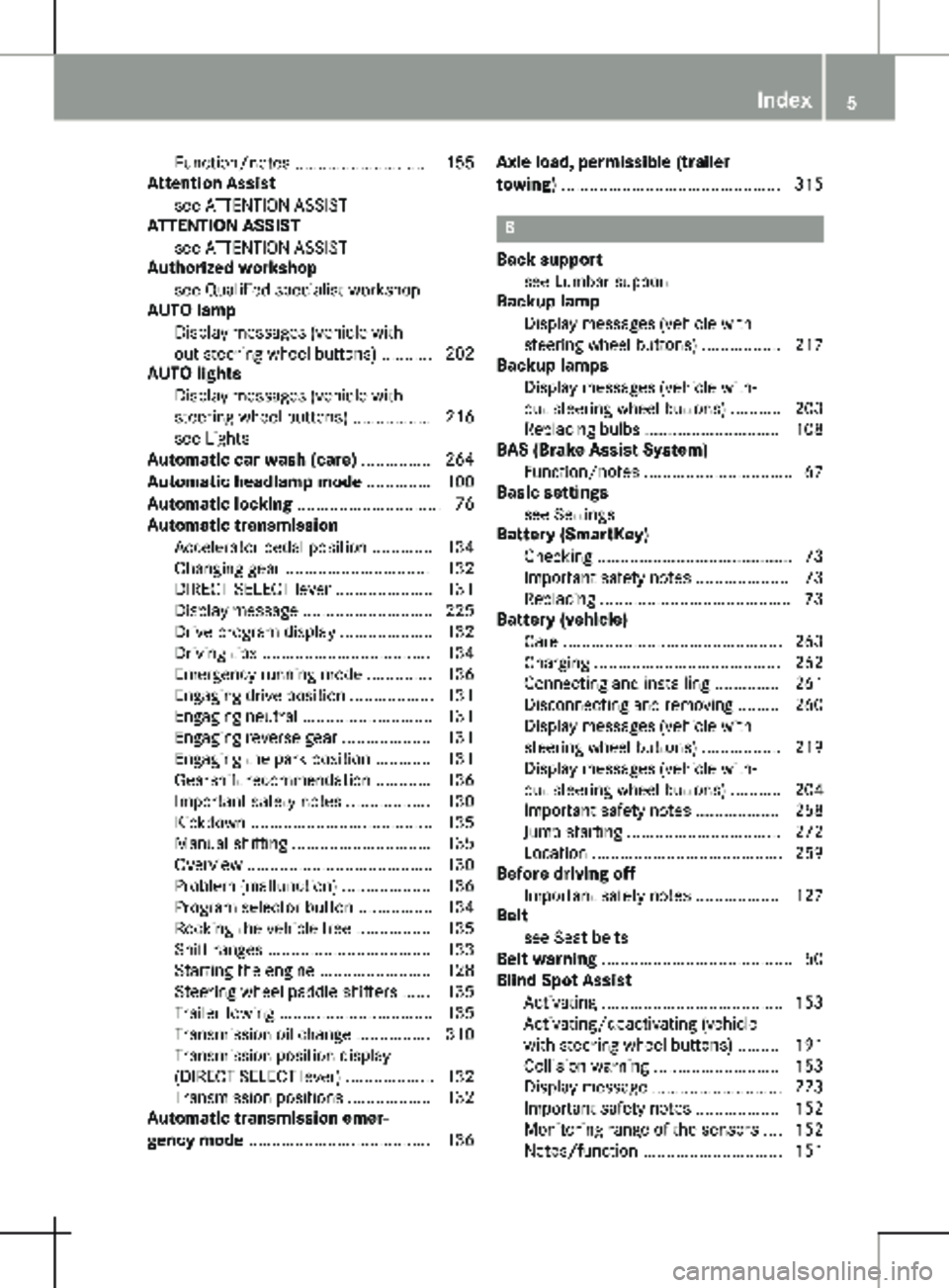
Function/notes ............................. 155
Attention Assist
see ATTENTION ASSIST
ATTENTION ASSIST
see ATTENTION ASSIST
Authorized workshop
see Qualified specialist workshop
AUTO lamp
Display messages (vehicle with-
out steering wheel buttons) ...........
202
AUTO lights
Display messages (vehicle with
steering wheel buttons) ................. 216
see Lights
Automatic car wash (care) ............... 264
Automatic headlamp mode .............. 100
Automatic locking ............................... 76
Automatic transmission
Accelerator pedal position ............. 134
Changing gear ............................... 132
DIRECT SELECT lever ..................... 131
Display message ............................ 225
Drive program display .................... 132
Driving tips .................................... 134
Emergency running mode .............. 136
Engaging drive position .................. 131
Engaging neutral ............................ 131
Engaging reverse gear ................... 131
Engaging the park position ............ 131
Gearshift recommendation ............ 136
Important safety notes .................. 130
Kickdown ....................................... 135
Manual shifting .............................. 135
Overview ........................................ 130
Problem (malfunction) ................... 136
Program selector button ................ 134
Rocking the vehicle free ................ 135
Shift ranges ................................... 133
Starting the engine ........................ 128
Steering wheel paddle shifters ...... 135
Trailer towing ................................. 135
Transmission oil change ................ 310
Transmission position display
(DIRECT SELECT lever) ................... 132
Transmission positions .................. 132
Automatic transmission emer-
gency mode ....................................... 136 Axle load, permissible (trailer
towing) ...............................................
315 B
Back support see Lumbar support
Backup lamp
Display messages (vehicle with
steering wheel buttons) .................
217
Backup lamps
Display messages (vehicle with-
out steering wheel buttons) ........... 203
Replacing bulbs ............................. 108
BAS (Brake Assist System)
Function/notes ................................ 67
Basic settings
see Settings
Battery (SmartKey)
Checking .......................................... 73
Important safety notes .................... 73
Replacing ......................................... 73
Battery (vehicle)
Care ............................................... 263
Charging ........................................ 262
Connecting and installing .............. 261
Disconnecting and removing ......... 260
Display messages (vehicle with
steering wheel buttons) ................. 219
Display messages (vehicle with-
out steering wheel buttons) ........... 204
Important safety notes .................. 258
Jump starting ................................. 272
Location ......................................... 259
Before driving off
Important safety notes .................. 127
Belt
see Seat belts
Belt warning ......................................... 50
Blind Spot Assist
Activating ....................................... 153
Activating/deactivating (vehicle
with steering wheel buttons) ......... 191
Collision warning ........................... 153
Display message ............................ 223
Important safety notes .................. 152
Monitoring range of the sensors .... 152
Notes/function .............................. 151 Index
5
Page 8 of 320
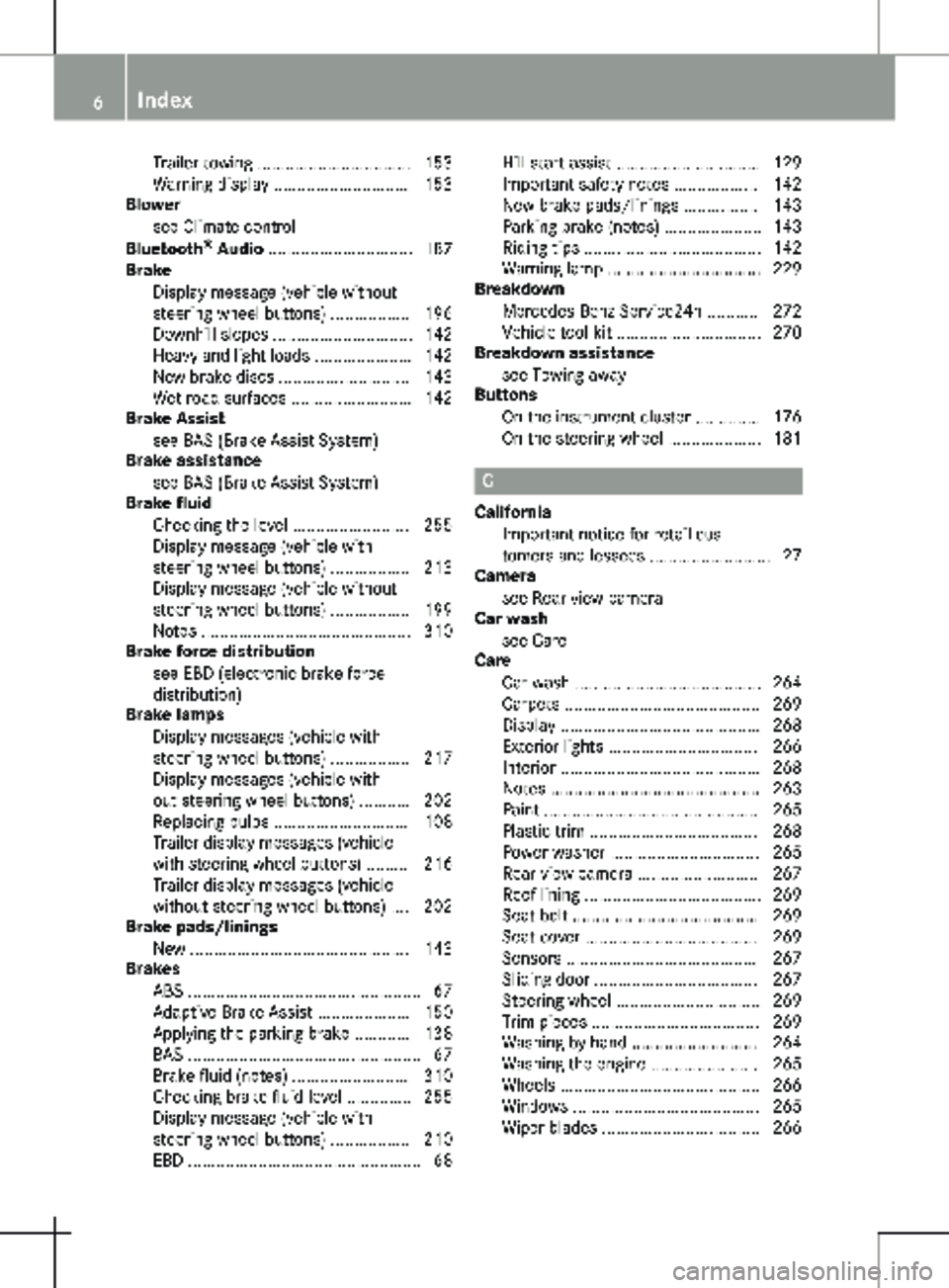
Trailer towing ................................. 153
Warning display
............................. 153
Blower
see Climate control
Bluetooth ®
Audio ............................... 187
Brake
Display message (vehicle without
steering wheel buttons) ................. 196
Downhill slopes .............................. 142
Heavy and light loads ..................... 142
New brake discs ............................ 143
Wet road surfaces .......................... 142
Brake Assist
see BAS (Brake Assist System)
Brake assistance
see BAS (Brake Assist System)
Brake fluid
Checking the level ......................... 255
Display message (vehicle with
steering wheel buttons) ................. 213
Display message (vehicle without
steering wheel buttons) ................. 199
Notes ............................................. 310
Brake force distribution
see EBD (electronic brake force
distribution)
Brake lamps
Display messages (vehicle with
steering wheel buttons) ................. 217
Display messages (vehicle with-
out steering wheel buttons) ........... 202
Replacing bulbs ............................. 108
Trailer display messages (vehicle
with steering wheel buttons) ......... 216
Trailer display messages (vehicle
without steering wheel buttons) .... 202
Brake pads/linings
New ............................................... 143
Brakes
ABS .................................................. 67
Adaptive Brake Assist .................... 150
Applying the parking brake ............ 138
BAS .................................................. 67
Brake fluid (notes) ......................... 310
Checking brake fluid level .............. 255
Display message (vehicle with
steering wheel buttons) ................. 210
EBD .................................................. 68 Hill start assist ............................... 129
Important safety notes
.................. 142
New brake pads/linings ................ 143
Parking brake (notes) ..................... 143
Riding tips ...................................... 142
Warning lamp ................................. 229
Breakdown
Mercedes-Benz Service24h ........... 272
Vehicle tool kit ............................... 270
Breakdown assistance
see Towing away
Buttons
On the instrument cluster .............. 176
On the steering wheel .................... 181 C
California Important notice for retail cus-
tomers and lessees ..........................
27
Camera
see Rear view camera
Car wash
see Care
Care
Car wash ........................................ 264
Carpets .......................................... 269
Display ........................................... 268
Exterior lights ................................ 266
Interior ........................................... 268
Notes ............................................. 263
Paint .............................................. 265
Plastic trim .................................... 268
Power washer ................................ 265
Rear view camera .......................... 267
Roof lining ...................................... 269
Seat belt ........................................ 269
Seat cover ..................................... 269
Sensors ......................................... 267
Sliding door ................................... 267
Steering wheel ............................... 269
Trim pieces .................................... 269
Washing by hand ........................... 264
Washing the engine ....................... 265
Wheels ........................................... 266
Windows ........................................ 265
Wiper blades .................................. 266 6
Index
Page 9 of 320
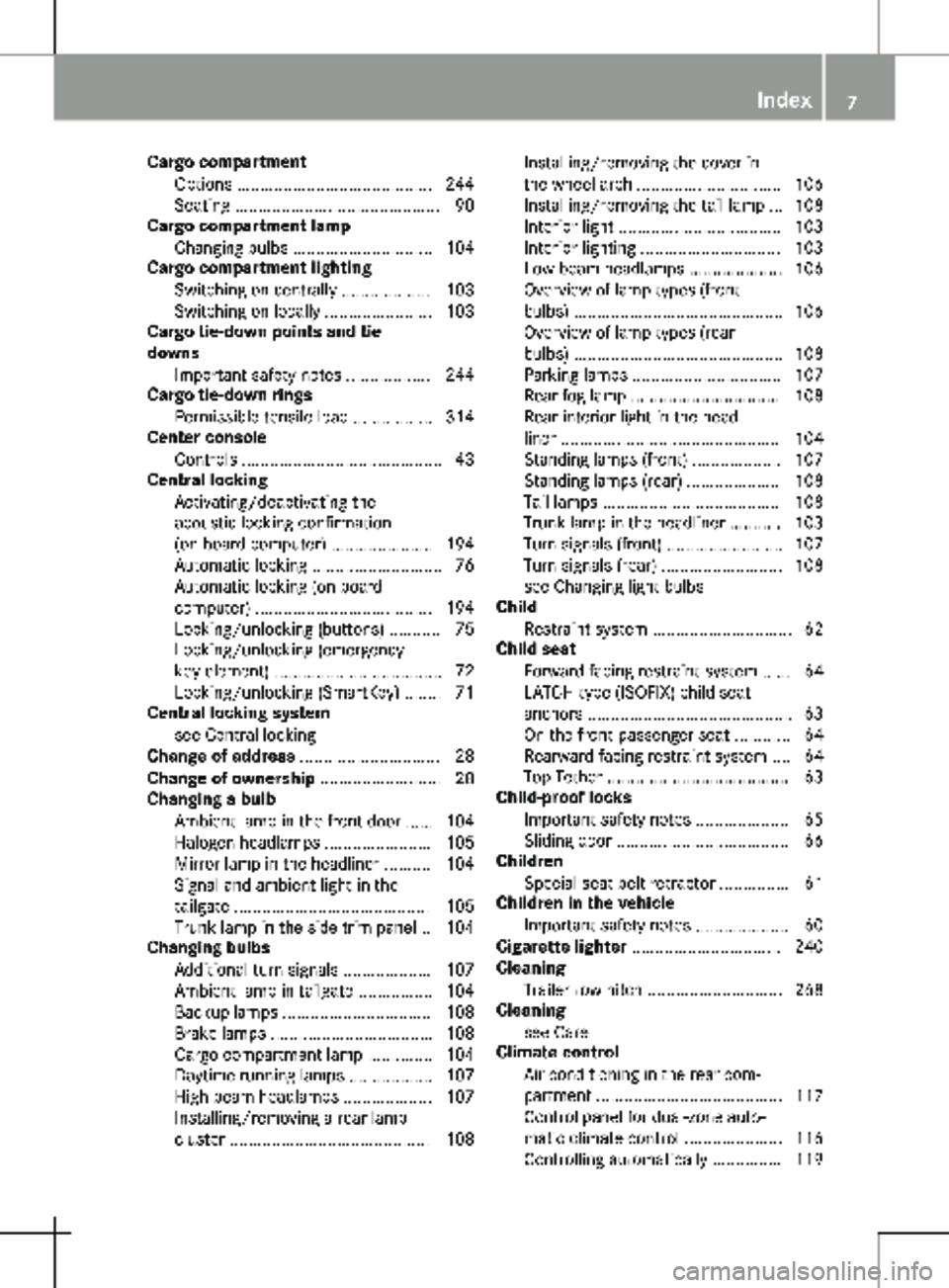
Cargo compartment
Options .......................................... 244
Seating ............................................ 90
Cargo compartment lamp
Changing bulbs .............................. 104
Cargo compartment lighting
Switching on centrally ................... 103
Switching on locally ....................... 103
Cargo tie-down points and tie
downs
Important safety notes .................. 244
Cargo tie-down rings
Permissible tensile load ................. 314
Center console
Controls ........................................... 43
Central locking
Activating/deactivating the
acoustic locking confirmation
(on-board computer) ...................... 194
Automatic locking ............................ 76
Automatic locking (on-board
computer) ...................................... 194
Locking/unlocking (buttons) ........... 75
Locking/unlocking (emergency
key element) .................................... 72
Locking/unlocking (SmartKey) ........ 71
Central locking system
see Central locking
Change of address .............................. 28
Change of ownership .......................... 28
Changing a bulb
Ambient lamp in the front door ...... 104
Halogen headlamps ....................... 105
Mirror lamp in the headliner .......... 104
Signal and ambient light in the
tailgate .......................................... 105
Trunk lamp in the side trim panel .. 104
Changing bulbs
Additional turn signals ................... 107
Ambient lamp in tailgate ................ 104
Backup lamps ................................ 108
Brake lamps ................................... 108
Cargo compartment lamp .............. 104
Daytime running lamps .................. 107
High-beam headlamps ................... 107
Installing/removing a rear lamp
cluster ........................................... 108 Installing/removing the cover in
the wheel arch
............................... 106
Installing/removing the tail lamp ... 108
Interior light ................................... 103
Interior lighting .............................. 103
Low-beam headlamps .................... 106
Overview of lamp types (front
bulbs) ............................................. 106
Overview of lamp types (rear
bulbs) ............................................. 108
Parking lamps ................................ 107
Rear fog lamp ................................ 108
Rear interior light in the head-
liner ............................................... 104
Standing lamps (front) ................... 107
Standing lamps (rear) .................... 108
Tail lamps ...................................... 108
Trunk lamp in the headliner ........... 103
Turn signals (front) ......................... 107
Turn signals (rear) .......................... 108
see Changing light bulbs
Child
Restraint system .............................. 62
Child seat
Forward-facing restraint system ...... 64
LATCH-type (ISOFIX) child seat
anchors ............................................ 63
On the front-passenger seat ............ 64
Rearward-facing restraint system .... 64
Top Tether ....................................... 63
Child-proof locks
Important safety notes .................... 65
Sliding door ..................................... 66
Children
Special seat belt retractor ............... 61
Children in the vehicle
Important safety notes .................... 60
Cigarette lighter ................................ 240
Cleaning
Trailer tow hitch ............................. 268
Cleaning
see Care
Climate control
Air conditioning in the rear com-
partment ........................................ 117
Control panel for dual-zone auto-
matic climate control ..................... 116
Controlling automatically ............... 119 Index
7
Page 15 of 320
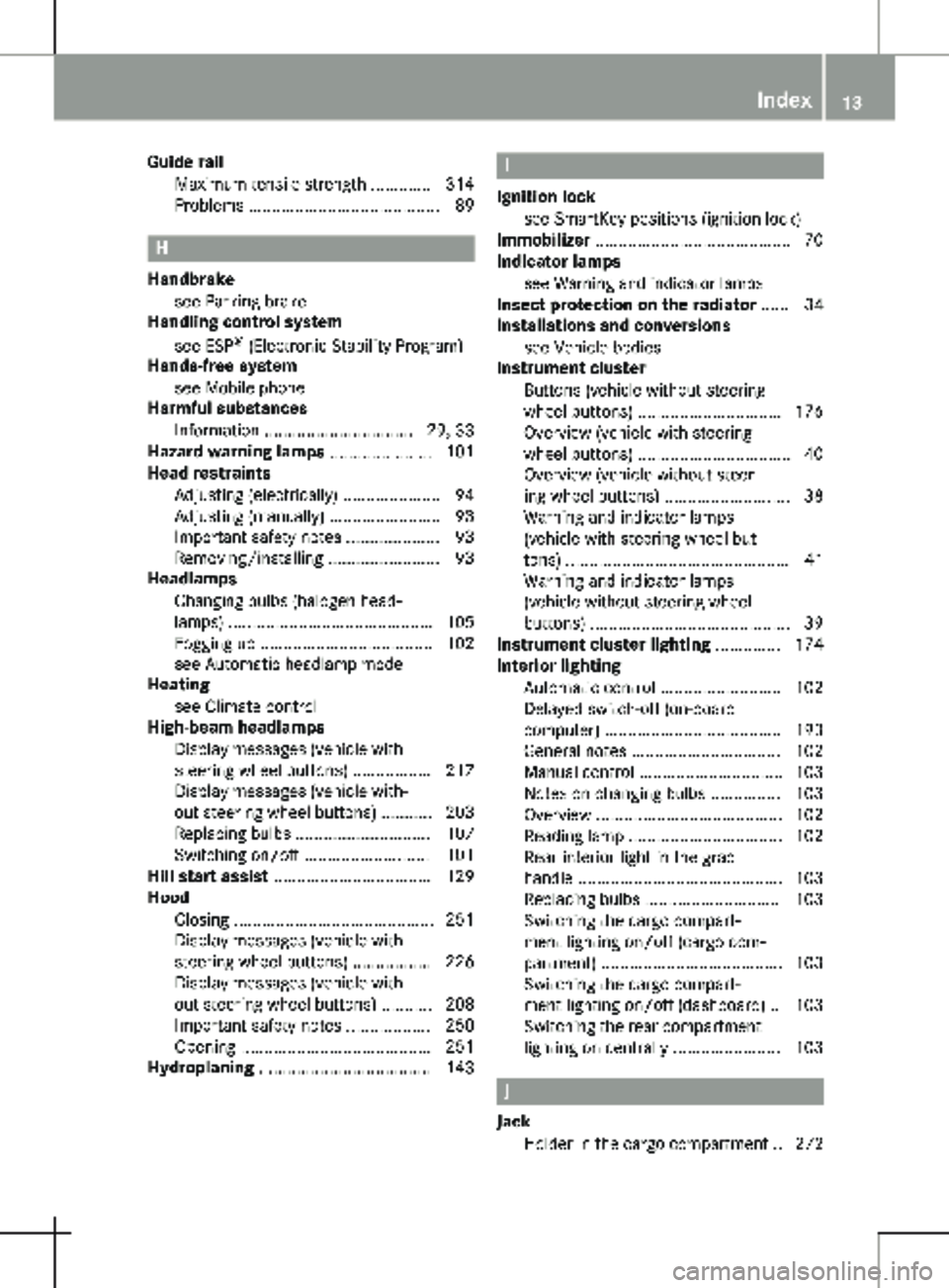
Guide rail
Maximum tensile strength ............. 314
Problems ......................................... 89 H
Handbrake see Parking brake
Handling control system
see ESP ®
(Electronic Stability Program)
Hands-free system
see Mobile phone
Harmful substances
Information
................................ 29, 33
Hazard warning lamps ...................... 101
Head restraints
Adjusting (electrically) ..................... 94
Adjusting (manually) ........................ 93
Important safety notes .................... 93
Removing/installing ........................ 93
Headlamps
Changing bulbs (halogen head-
lamps) ............................................ 105
Fogging up ..................................... 102
see Automatic headlamp mode
Heating
see Climate control
High-beam headlamps
Display messages (vehicle with
steering wheel buttons) ................. 217
Display messages (vehicle with-
out steering wheel buttons) ........... 203
Replacing bulbs ............................. 107
Switching on/off ........................... 101
Hill start assist .................................. 129
Hood
Closing ........................................... 251
Display messages (vehicle with
steering wheel buttons) ................. 226
Display messages (vehicle with-
out steering wheel buttons) ........... 208
Important safety notes .................. 250
Opening ......................................... 251
Hydroplaning ..................................... 143 I
Ignition lock see SmartKey positions (ignition lock)
Immobilizer ..........................................
70
Indicator lamps
see Warning and indicator lamps
Insect protection on the radiator ...... 34
Installations and conversions
see Vehicle bodies
Instrument cluster
Buttons (vehicle without steering
wheel buttons) ............................... 176
Overview (vehicle with steering
wheel buttons) ................................. 40
Overview (vehicle without steer-
ing wheel buttons) ........................... 38
Warning and indicator lamps
(vehicle with steering wheel but-
tons) ................................................ 41
Warning and indicator lamps
(vehicle without steering wheel
buttons) ........................................... 39
Instrument cluster lighting .............. 174
Interior lighting
Automatic control .......................... 102
Delayed switch-off (on-board
computer) ...................................... 193
General notes ................................ 102
Manual control ............................... 103
Notes on changing bulbs ............... 103
Overview ........................................ 102
Reading lamp ................................. 102
Rear interior light in the grab
handle ............................................ 103
Replacing bulbs ............................. 103
Switching the cargo compart-
ment lighting on/off (cargo com-
partment) ....................................... 103
Switching the cargo compart-
ment lighting on/off (dashboard) .. 103
Switching the rear compartment
lighting on centrally ....................... 103 J
Jack Holder in the cargo compartment
.. 272 Index
13
Page 37 of 320
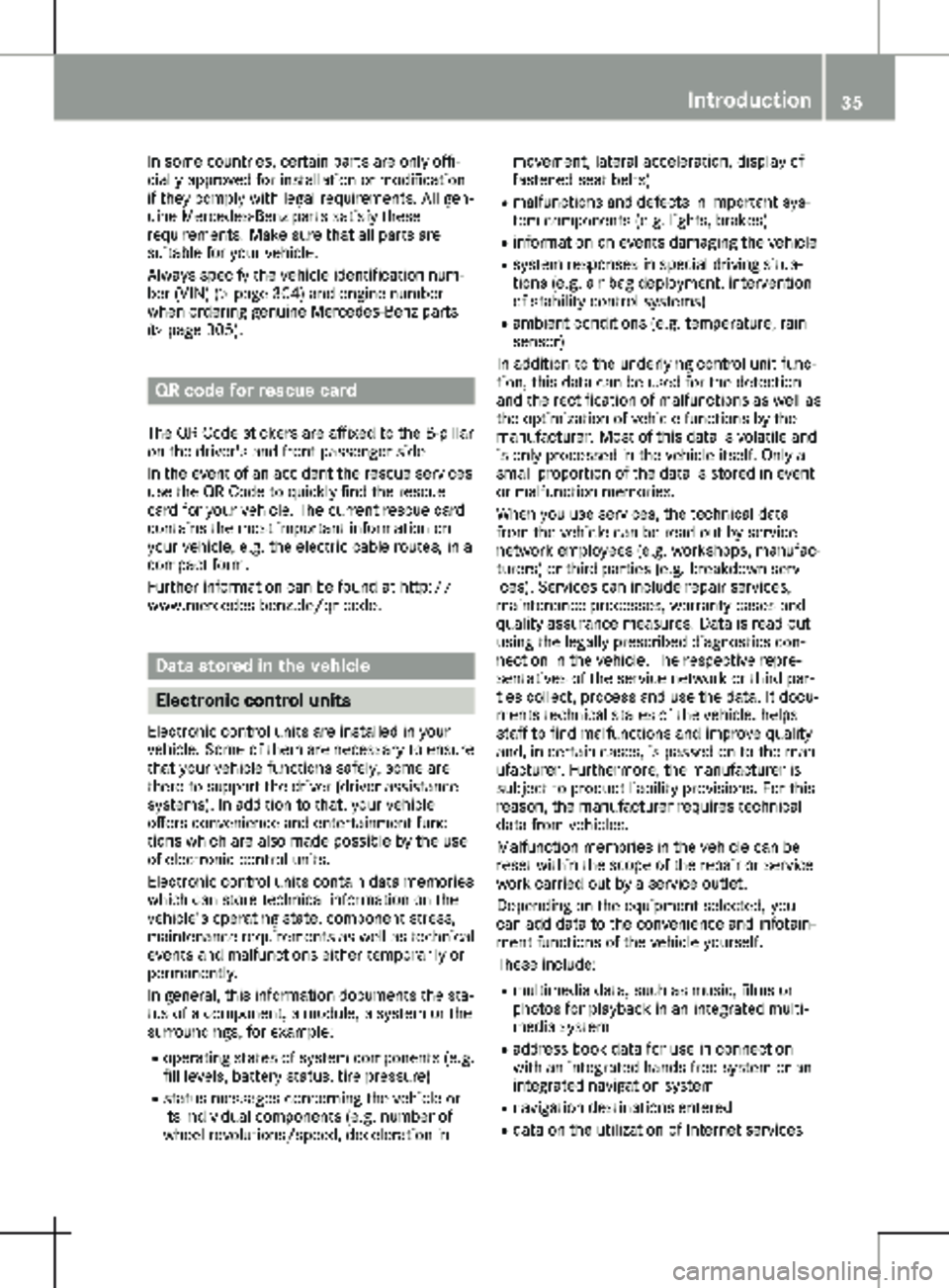
In some countries, certain parts are only offi-
cially approved for installation or modification
if they comply with legal requirements. All gen-
uine Mercedes-Benz parts satisfy these
requirements. Make sure that all parts are
suitable for your vehicle.
Always specify the vehicle identification num-
ber (VIN) ( Y page
304) and engine number
when ordering genuine Mercedes-Benz parts
(Y page 305). QR code for rescue card
The QR Code stickers are affixed to the B-pillar
on the driver's and front-passenger side.
In the event of an accident the rescue services
use the QR Code to quickly find the rescue
card for your vehicle. The current rescue card
contains the most important information on
your vehicle, e.g. the electric cable routes, in a
compact form.
Further information can be found at http://
www.mercedes-benz.de/qr-code. Data stored in the vehicle
Electronic control units
Electronic control units are installed in your
vehicle. Some of them are necessary to ensure
that your vehicle functions safely, some are
there to support the driver (driver assistance
systems). In addition to that, your vehicle
offers convenience and entertainment func-
tions which are also made possible by the use
of electronic control units.
Electronic control units contain data memories
which can store technical information on the
vehicle's operating state, component stress,
maintenance requirements as well as technical
events and malfunctions either temporarily or
permanently.
In general, this information documents the sta-
tus of a component, a module, a system or the
surroundings, for example:
R operating states of system components (e.g.
fill levels, battery status, tire pressure)
R status messages concerning the vehicle or
its individual components (e.g. number of
wheel revolutions/speed, deceleration in movement, lateral acceleration, display of
fastened seat belts)
R malfunctions and defects in important sys-
tem components (e.g. lights, brakes)
R information on events damaging the vehicle
R system responses in special driving situa-
tions (e.g. air bag deployment, intervention
of stability control systems)
R ambient conditions (e.g. temperature, rain
sensor)
In addition to the underlying control unit func-
tion, this data can be used for the detection
and the rectification of malfunctions as well as
the optimization of vehicle functions by the
manufacturer. Most of this data is volatile and
is only processed in the vehicle itself. Only a
small proportion of the data is stored in event
or malfunction memories.
When you use services, the technical data
from the vehicle can be read out by service
network employees (e.g. workshops, manufac-
turers) or third parties (e.g. breakdown serv-
ices). Services can include repair services,
maintenance processes, warranty cases and
quality assurance measures. Data is read out
using the legally prescribed diagnostics con-
nection in the vehicle. The respective repre-
sentatives of the service network or third par-
ties collect, process and use the data. It docu-
ments technical states of the vehicle, helps
staff to find malfunctions and improve quality
and, in certain cases, is passed on to the man-
ufacturer. Furthermore, the manufacturer is
subject to product liability provisions. For this
reason, the manufacturer requires technical
data from vehicles.
Malfunction memories in the vehicle can be
reset within the scope of the repair or service
work carried out by a service outlet.
Depending on the equipment selected, you
can add data to the convenience and infotain-
ment functions of the vehicle yourself.
These include:
R multimedia data, such as music, films or
photos for playback in an integrated multi-
media system
R address book data for use in connection
with an integrated hands-free system or an
integrated navigation system
R navigation destinations entered
R data on the utilization of Internet services Introduction
35 Z
Page 39 of 320
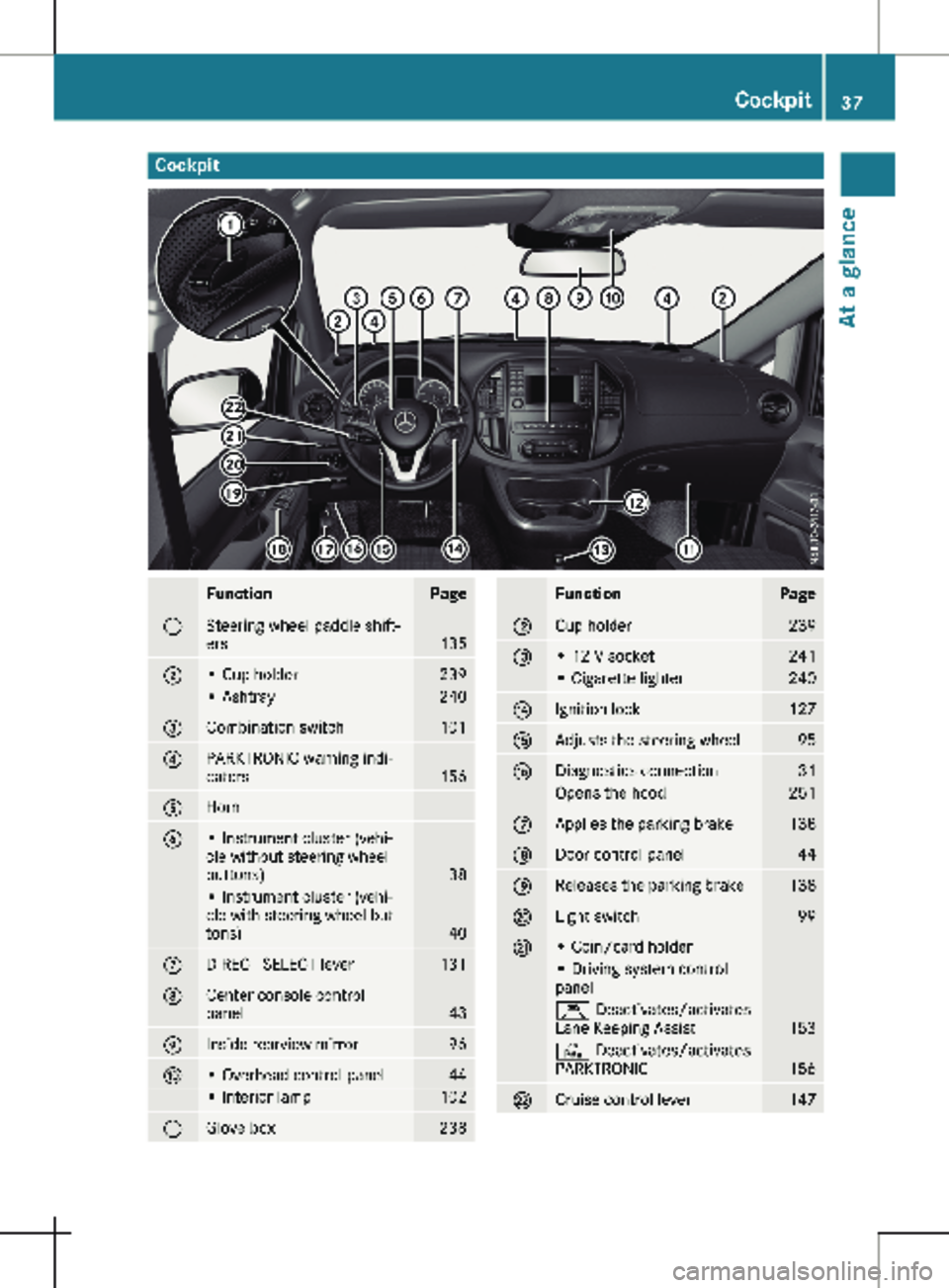
Cockpit
Function Page
:
Steering wheel paddle shift-
ers
135
;
• Cup holder 239
• Ashtray 240
=
Combination switch 101
?
PARKTRONIC warning indi-
cators
156
A
Horn
B
• Instrument cluster (vehi-
cle without steering wheel
buttons)
38
• Instrument cluster (vehi-
cle with steering wheel but-
tons)
40
C
DIRECT SELECT lever 131
D
Center console control
panel
43
E
Inside rearview mirror 96
F
• Overhead control panel 44
• Interior lamp 102
G
Glove box 238 Function Page
H
Cup holder 239
I
• 12 V socket 241
• Cigarette lighter 240
J
Ignition lock 127
K
Adjusts the steering wheel 95
L
Diagnostics connection 31
Opens the hood 251
M
Applies the parking brake 138
N
Door control panel 44
O
Releases the parking brake 138
P
Light switch 99
Q
• Coin/card holder
• Driving system control
panel
Ç Deactivates/activates
Lane Keeping Assist
153
c Deactivates/activates
PARKTRONIC
156
R
Cruise control lever 147Cockpit
37At a glance
Page 63 of 320
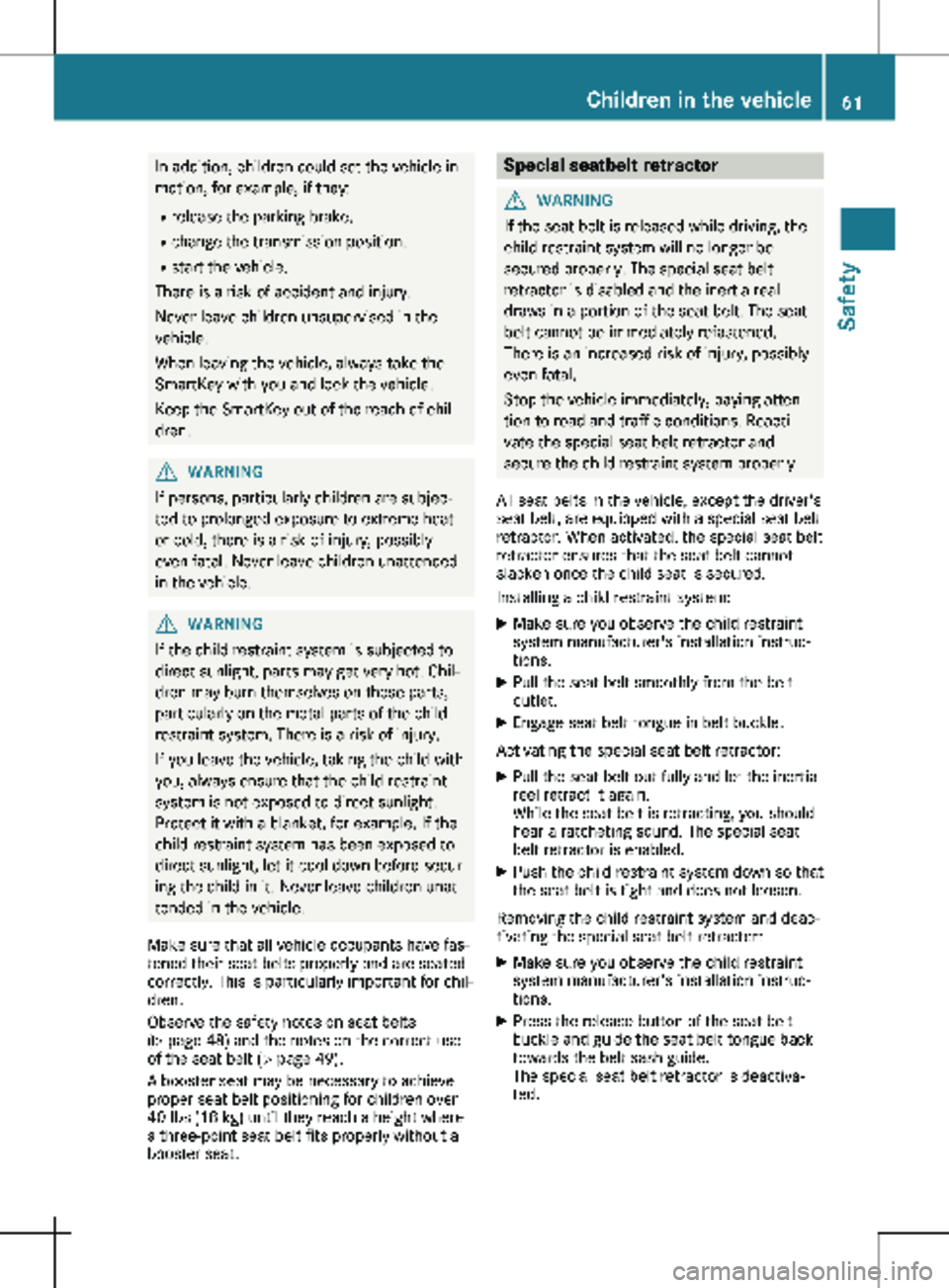
In addition, children could set the vehicle in
motion, for example, if they:
R release the parking brake.
R change the transmission position.
R start the vehicle.
There is a risk of accident and injury.
Never leave children unsupervised in the
vehicle.
When leaving the vehicle, always take the
SmartKey with you and lock the vehicle.
Keep the SmartKey out of the reach of chil-
dren. G
WARNING
If persons, particularly children are subjec-
ted to prolonged exposure to extreme heat
or cold, there is a risk of injury, possibly
even fatal. Never leave children unattended
in the vehicle. G
WARNING
If the child restraint system is subjected to
direct sunlight, parts may get very hot. Chil-
dren may burn themselves on these parts,
particularly on the metal parts of the child
restraint system. There is a risk of injury.
If you leave the vehicle, taking the child with
you, always ensure that the child restraint
system is not exposed to direct sunlight.
Protect it with a blanket, for example. If the
child restraint system has been exposed to
direct sunlight, let it cool down before secur-
ing the child in it. Never leave children unat-
tended in the vehicle.
Make sure that all vehicle occupants have fas-
tened their seat belts properly and are seated
correctly. This is particularly important for chil-
dren.
Observe the safety notes on seat belts
(Y page
48) and the notes on the correct use
of the seat belt (Y page 49).
A booster seat may be necessary to achieve
proper seat belt positioning for children over
40 lbs (18 kg) until they reach a height where
a three-point seat belt fits properly without a
booster seat. Special seatbelt retractor
G
WARNING
If the seat belt is released while driving, the
child restraint system will no longer be
secured properly. The special seat belt
retractor is disabled and the inertia real
draws in a portion of the seat belt. The seat
belt cannot be immediately refastened.
There is an increased risk of injury, possibly
even fatal.
Stop the vehicle immediately, paying atten-
tion to road and traffic conditions. Reacti-
vate the special seat belt retractor and
secure the child restraint system properly.
All seat belts in the vehicle, except the driver's
seat belt, are equipped with a special seat belt
retractor. When activated, the special seat belt
retractor ensures that the seat belt cannot
slacken once the child seat is secured.
Installing a child restraint system:
X Make sure you observe the child restraint
system manufacturer's installation instruc-
tions.
X Pull the seat belt smoothly from the belt
outlet.
X Engage seat belt tongue in belt buckle.
Activating the special seat belt retractor:
X Pull the seat belt out fully and let the inertia
reel retract it again.
While the seat belt is retracting, you should
hear a ratcheting sound. The special seat
belt retractor is enabled.
X Push the child restraint system down so that
the seat belt is tight and does not loosen.
Removing the child restraint system and deac-
tivating the special seat belt retractor:
X Make sure you observe the child restraint
system manufacturer's installation instruc-
tions.
X Press the release button of the seat belt
buckle and guide the seat belt tongue back
towards the belt sash guide.
The special seat belt retractor is deactiva-
ted. Children in the vehicle
61
Safety Z
Page 67 of 320
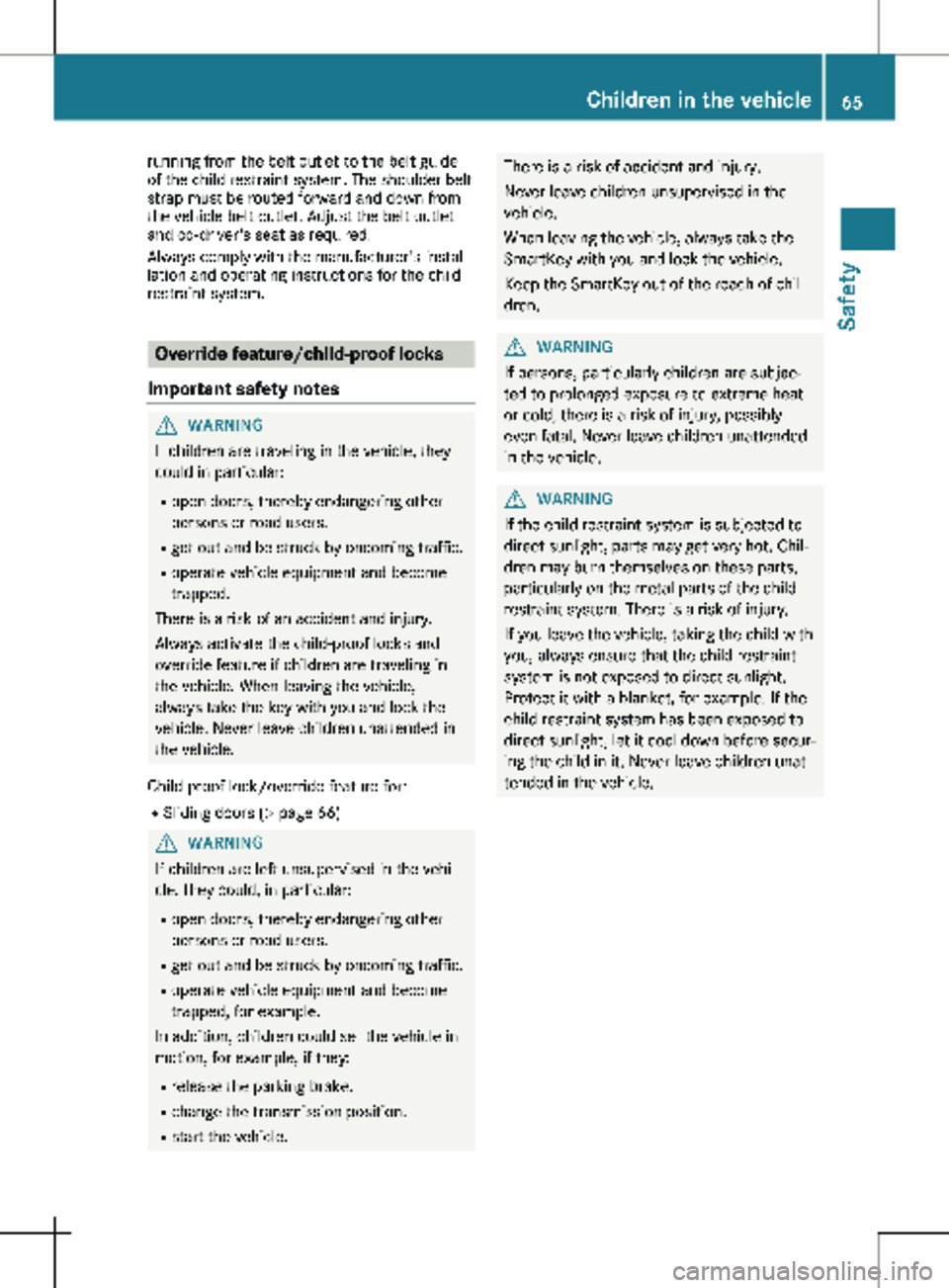
running from the belt outlet to the belt guide
of the child restraint system. The shoulder belt
strap must be routed forward and down from
the vehicle belt outlet. Adjust the belt outlet
and co-driver's seat as required.
Always comply with the manufacturer's instal-
lation and operating instructions for the child
restraint system. Override feature/child-proof locks
Important safety notes G
WARNING
If children are traveling in the vehicle, they
could in particular:
R open doors, thereby endangering other
persons or road users.
R get out and be struck by oncoming traffic.
R operate vehicle equipment and become
trapped.
There is a risk of an accident and injury.
Always activate the child-proof locks and
override feature if children are traveling in
the vehicle. When leaving the vehicle,
always take the key with you and lock the
vehicle. Never leave children unattended in
the vehicle.
Child-proof lock/override feature for:
R Sliding doors ( Y page
66)G
WARNING
If children are left unsupervised in the vehi-
cle, they could, in particular:
R open doors, thereby endangering other
persons or road users.
R get out and be struck by oncoming traffic.
R operate vehicle equipment and become
trapped, for example.
In addition, children could set the vehicle in
motion, for example, if they:
R release the parking brake.
R change the transmission position.
R start the vehicle. There is a risk of accident and injury.
Never leave children unsupervised in the
vehicle.
When leaving the vehicle, always take the
SmartKey with you and lock the vehicle.
Keep the SmartKey out of the reach of chil-
dren.
G
WARNING
If persons, particularly children are subjec-
ted to prolonged exposure to extreme heat
or cold, there is a risk of injury, possibly
even fatal. Never leave children unattended
in the vehicle. G
WARNING
If the child restraint system is subjected to
direct sunlight, parts may get very hot. Chil-
dren may burn themselves on these parts,
particularly on the metal parts of the child
restraint system. There is a risk of injury.
If you leave the vehicle, taking the child with
you, always ensure that the child restraint
system is not exposed to direct sunlight.
Protect it with a blanket, for example. If the
child restraint system has been exposed to
direct sunlight, let it cool down before secur-
ing the child in it. Never leave children unat-
tended in the vehicle. Children in the vehicle
65
Safety Z
Page 69 of 320

ABS (Anti-lock Braking System)
General notes ABS regulates brake pressure in such a way
that the wheels do not lock when you brake.
This allows you to continue steering the vehi-
cle when braking.
The ò warning lamp in the instrument clus-
ter lights up when the ignition is switched on.
The lamp goes out when the engine starts run-
ning.
Important safety notes Observe the important safety guidelines for
the driving safety system (
Y page
66).
ABS works from a speed of about 5 mph
(8 km/h), regardless of road-surface condi-
tions. ABS works on slippery surfaces, even
when you only brake gently. G
WARNING
If ABS is faulty, the wheels could lock when
braking. The steerability and braking charac-
teristics may be severely impaired. Addition-
ally, further driving safety systems are deac-
tivated. There is an increased danger of
skidding and accidents.
Drive on carefully. Have ABS checked imme-
diately at a qualified specialist workshop.
If ABS is malfunctioning, the ò warning
lamp
(Y page 230) lights up while the engine
is running and the display shows a message:
R on vehicles without steering wheel buttons
(Y page 196)
R on vehicles with steering wheel buttons
(Y page 210)
BAS, Hill Start Assist and ESP ®
and its driving
safety systems and other driving systems also
fail. Observe the notes on the ò warning
lamp and the display messages.
Braking If ABS intervenes when braking, you will feel a
pulsating in the brake pedal.
The pulsating brake pedal can be an indication
of hazardous road conditions and functions as
a reminder to take extra care while driving. X
If ABS intervenes: continue to depress the
brake pedal with force until the braking sit-
uation is over.
X To make a full brake application: depress
the brake pedal with full force. BAS (Brake Assist System)
General notes BAS operates in emergency braking situations.
If you depress the brake pedal quickly, BAS
automatically boosts the braking force, thus
shortening the stopping distance.
Important safety notes Observe the important safety guidelines for
the driving safety system
(Y page 66). G
WARNING
If BAS is malfunctioning, the braking dis-
tance in an emergency braking situation is
increased. There is a risk of an accident.
In an emergency braking situation, depress
the brake pedal with full force. ABS prevents
the wheels from locking.
If BAS is malfunctioning, the ÷ warning
lamp lights up while the engine is running
(Y page
230) and the display shows a mes-
sage:
R on vehicles without steering wheel buttons
(Y page 200)
R on vehicles with steering wheel buttons
(Y page 214)
Braking X
Keep the brake pedal firmly depressed until
the emergency braking situation is over.
ABS prevents the wheels from locking.
The brakes will function as usual once you
release the brake pedal. BAS is deactivated. Driving safety systems
67
Safety Z
Page 70 of 320

EBD (electronic brake force distribu-
tion)
General notes EBD monitors and controls the brake pressure
to the rear wheels. This enables EBD to
improve handling during braking.
Important safety notes Observe the important safety guidelines for
the driving safety system
(Y page 66).G
WARNING
If EBD is malfunctioning, the rear wheels can
lock, e.g. under full braking. This increases
the risk of skidding and an accident.
You should therefore adapt your driving
style to the different handling characteris-
tics. Have the brake system checked at a
qualified specialist workshop.
If EBD is malfunctioning, the $ warning
lamp
(Y page 229) lights up while the engine
is running and the display shows a message:
R on vehicles without steering wheel buttons
(Y page 199)
R on vehicles with steering wheel buttons
(Y page 213)
Other driving systems and driving safety sys-
tems then also fail. ESP
®
(Electronic Stability Program)
General notes ESP
®
monitors driving stability and detects a
tendency of the vehicle to understeer or over-
steer (skidding) in good time. If ESP ®
detects
that the vehicle is deviating from the direction
desired by the driver, one or more wheels are
braked to stabilize the vehicle. The engine out-
put is also modified to keep the vehicle on the
desired course within physical limits. ESP ®
can
also stabilize the vehicle during braking.
ESP ®
also monitors traction, i.e. power trans-
mission between the tires and the road sur-
face. The integrated traction control supports
you when pulling away or accelerating on wet,
slippery or slick roads. Should the drive
wheels spin, traction control brakes them indi- vidually. In addition, greater drive torque is
transmitted to the wheel or wheels with trac-
tion. If traction on the road surface is not suffi-
cient, even ESP
®
will not allow you to pull
away without difficulty. The type of tires and
total weight of the vehicle as well as the gradi-
ent of the road also play a crucial role. Trac-
tion control remains active if you deactivate
ESP ®
.
If the h warning lamp in the instrument
cluster goes out before beginning the journey,
ESP ®
is automatically active.
The h warning lamp in the instrument clus-
ter flashes when ESP ®
intervenes:
X do not deactivate ESP ®
under any circum-
stances.
X when driving off, apply as little throttle as
possible.
X adapt your speed and driving style to the
prevailing road conditions.
Important safety notes Observe the important safety guidelines for
the driving safety system (
Y page
66). G
WARNING
If ESP ®
is malfunctioning it will not provide
any vehicle stabilization. There is an
increased risk of skidding or of an accident.
Exercise caution when continuing to drive.
Have ESP ®
checked at a qualified specialist
workshop.
! Do not run the vehicle on a roller dyna-
mometer (e.g. for performance tests). If you
must operate the vehicle on a roller dyna-
mometer, please consult a qualified special-
ist workshop in advance. You could other-
wise damage the drive train or the brake
system.
If ESP ®
is malfunctioning, the h warning
lamp
(Y page 230) lights up continuously
while the engine is running and the display
shows a message.
R on vehicles without steering wheel buttons
(Y page 200)
R on vehicles with steering wheel buttons
(Y page 214) 68
Driving safety systems
Safety